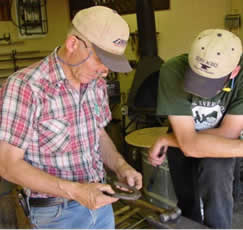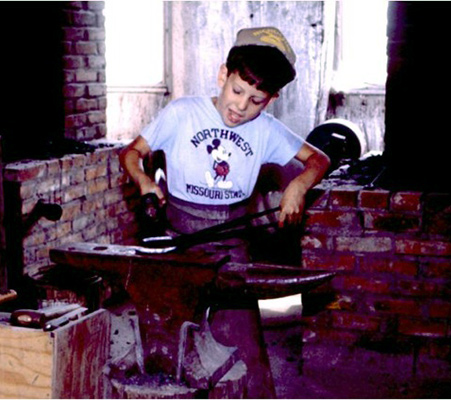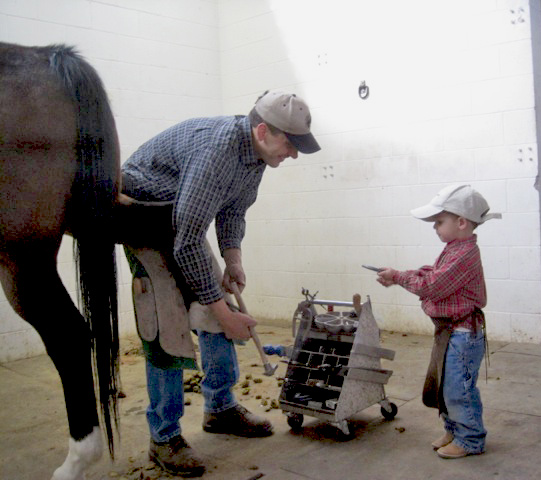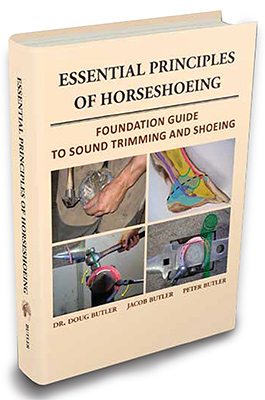 |
 |
|
How to Involve Youth in the Horse Industry
Jacob Butler CJF, AWCF
Butler Professional Farrier School LLC
From a very early age I grew up around horses. Both of my parents helped spark that interest as we had horses throughout
my childhood. During many summers, we had a “riding camp” where we learned how to take care of our own horses. My
siblings and I learned responsibility this way. My interest continues to grow as I train others to take care of horses brought to
our Butler Professional Farrier School. I will be forever grateful for experiences that I have had that helped shape my desire and interest.
My motivation to want to be a farrier started as I would follow my Dad, Doug  Butler, around as he shod horses. I enjoy the
different aspects and skill areas of being a farrier. I appreciate all my Dad did to fuel my desire toward learning and becoming a professional farrier. It is interesting
to see how things have come full circle as my own children begin to show interest and discover different aspects of horses for the first time. Butler, around as he shod horses. I enjoy the
different aspects and skill areas of being a farrier. I appreciate all my Dad did to fuel my desire toward learning and becoming a professional farrier. It is interesting
to see how things have come full circle as my own children begin to show interest and discover different aspects of horses for the first time.
The future of our horse industry depends upon motivated youth to carry it forward. It has always been this way. Two years ago, Dr. Butler was asked to speak on
methods of teaching Horse Foot Care at the American Youth Horse Council Symposium in Hartford, Connecticut. This group brings together those interested in
reaching youth with trusted information emphasizing humane horse care. Many youth organizations were represented. Their Horse Industry Handbook has an
entire section on “Horse Foot Care” written by Dr. Doug Butler. The American Youth Council encourages high standards.
The Pony Club, originally started in Great Britain in 1929, is the world’s largest junior equestrian organization. They have 50
,000 members in the UK and over 100,000 members in 27 countries. The word ‘pony’ was used to indicate the youthful age of members, not the size of their animals.
The United States Pony Clubs, Inc. (USPC) is for youth under 21. It was established in 1954 in Virginia and was patterned
after the British Pony Clubs. By 1984, it had grown to 380 clubs in 47 states and nearly 11,000 members. Many of the top
international riders have come up through the levels from D to A riders in Pony Club. Club members are not only taught
riding skills, but also learn everything about the basic care of horses. They learn that to be a happy horse owner, the horse
must be happy as well. Oral, written, and practical tests are a part of every club’s activities.
 |
According to Rufus Weston, a USPC past president: “It is the objective of pony club to instill in every Pony Clubber a love
of horses and an ability to care for and enjoy horses for the rest of his life and through this contribute to his development as a
well rounded, self-disciplined and responsible citizen. If we have done these things, we will have done a good job.”
The Land Grant College Act was passed in 1862. The Hatch Act, signed by President Grover Cleveland, March 2, 1887,
established an Agricultural Extension Service. This opened the door for the beginning of 4-H in America. In 1890 the Land
Grant Colleges joined the system. In New York State it was helped along with the passing of the Experiment Station
Extension bill in 1894 by the Legislature. In 1914 the Smith-Lever Act provided funds for a national system for rural adult
vocational education at Land Grant Colleges. Eventually funds were provided for youth education in agriculture.
4-H has become one of the most successful programs for youth development. Starting in about 1902 in the Midwest, the
numbers involved have steadily grown. For example, in 1995 in New York State over 500,000 youth participated. Currently
, nationwide, there are 6.5 Million 4-H club members from ages 5 to 21 [in some states youth must be 8 or over] in 90,000
clubs and 540,000 leaders. The 4 H’s stand for Head, Heart, Hands, and Health. Their motto is “To make the best better”
and their slogan is “Learn by doing.” My older children are learning much in 4-H. I have enjoyed participating and teaching in 4-H camps and forums designed for youth in our region.
Dr. Harold Willman went to Cornell University in 1929 from a farm in Pennsylvania. He prepared 4-H materials for all
species during his long career before he retired in 1965. In 1981, a foundation was started that bears Willman’s name for 4-H youth development.
 |
4-H Clubs originally involved gardening and all farm animals including heavy or draft horses. Dr. Willman made possible the
organization of the first light horse 4-H Club in the United States. It was organized in March of 1952 in the home of Karl and
Mollie Butler in Ithaca, New York. It was called “The Hackin’ Horse Club.” There were 62 youth present – 60 girls and 2
boys. Doug Butler was one of those boys. His sister Linda was elected president and Sue McElwee was elected secretary.
Many of those present went on to careers in the horse industry. Mollie Butler and Elsie Williams were the first leaders.
4-Hers are taught by their leaders the principles of horsemanship and especially horse care. It is never too early to learn to
take good care of our equine friends. We salute the sacrifice and good work of dedicated youth leaders. They believe in character development of our most precious resource – youth.
In 1991, Clint Brock and Catherine Brown won the National 4-H Horse Method Competition held in Denver, Colorado
using Dr. Butler’s publication Horse Foot Care as a resource for their award-winning presentation. Veterinarian Dr. Guy Rowland of Georgetown, Texas, was their 4-H advisor.
Our company, Doug Butler Enterprises, Inc., has produced a new book called Essential Principles of Horseshoeing for those desiring more information on horse foot care.
This is what Dr. Betsy Greene, at the University of New Hampshire, said after receiving her copy of Essential Principles of Horseshoeing:
I could use the book immediately to help students understand what the answers needed to be for the upcoming test in
my ‘Intro to Equine Studies course.’ The book is useful, applicable in showing good examples and good pictures of
the different types of structures and shapes. This book has a lot of useful information beyond just, I want to be a farrier.
Veterinarians have found the Essentials book helpful in encouraging owner education and teaching a practical approach to
solving soundness issues. Farriers have used the book to illustrate to clients procedures available to help horses perform their
best. The book helps horse owners understand how farriers and veterinarians can help their horse stay sound or return to soundness.
 In honor of youth efforts described in this article, when you order ONE COPY
of Essential Principles of Horseshoeing by 7 August 2015, you receive over 25% off its listed price and additional savings on shipping within U.S. domestic borders! Go to our shopping cart on dougbutler.com, press Purchase Book Only and enter Promotion Code 807 on Order Form). In honor of youth efforts described in this article, when you order ONE COPY
of Essential Principles of Horseshoeing by 7 August 2015, you receive over 25% off its listed price and additional savings on shipping within U.S. domestic borders! Go to our shopping cart on dougbutler.com, press Purchase Book Only and enter Promotion Code 807 on Order Form).
Other publications and dvd learning resources are also available, including our Farrier Foundation Home Study Course at the infohorse LINK to interior
Products page.
Our latest product, the Essential Anatomy Kit, is an educational model that
consists of the 9 bones of the lower leg. This kit includes an instructional DVD and study guide to help individuals learn the anatomy of the lower leg. Most
debilitating injuries and disease of the horse occur in the lower leg. The bones are cast plastic, which means they are not oily or smelly like real bone. The
tendon and ligament replicas (21) are made from colored leather. Putting this educational model together helps you learn and understand the position and function of these vital structures.
This can also be ordered on our website at dougbutler.com or for more information email me at Jacob@dougbutler.com.
The Internet can be a source of useful information. It also can be a source of useless and even dangerous information. A strong background in horse care
principles is necessary to make good use of much of the information available online today. And of course infohorse.com can be a great resource to learn about horses.
The future of our horse industry depends upon motivated youth who are taught by caring, dedicated and knowledgeable
teachers. An ideal source for horse-oriented youth to learn from is the trusted voice in farrier education – Doug Butler
Enterprises. Recommended as the “most affordable horseshoeing school,” Butler Professional Farrier School can help you
develop a financially rewarding career as you help horses perform at their best. You can get more information on line to begin the fascinating and rewarding career of a farrier at.butlerprofessionalfarrierschool.com.
I have found my farrier career to be most interesting and soul satisfying.
Jacob Butler is a Certified Journeyman Farrier and an Associate of the Worshipful Company of Farriers. He is the Director
and an instructor at Butler Professional Farrier School, LLC, located near Chadron, NE. For more information visit his website at butlerprofessionalfarrierschool.com, call (308)665-1510 or email him at Jacob@dougbutler.com.
|
 |
|
To advertise your horse product or service, Contact Ann
|
 |
|
InfoHorse.com, Horse Information Lives Here ® 12/31/2025
Contact Us to Advertise to over a million Horse Owners.
All images and content Copyright© 2015 by InfoHorse.com, Equusite.com.
Horse Owners are Dog Owners; Dog Product Information dognowner.com
|
 |
|
Articles, Academic Schools, Arena Maintenance, Animal Communicators, Barns, Barn and Accessories, Barn Equipment and Tractors, Breast Collars, Grooming Products for Horses, Hay Feeders, Horse Blankets, Horse Books, Horse Videos, Horse Breeders, Horse Camping Gear, Career Schools, Carts and Buggies, Horse Training Clinicians, Equestrian Clothing, Dogs and Puppies, Horse Fencing, Western Art & Furniture, Horse Property for Sale, Horse Products For Sale, Fly Control, Foal Care, Horse Footings, Horse Gifts, Horse Health and Nutrition, Hoof and Leg, Horse Insurance, John Lyons Certified Trainers, Equine Lawyers, Leather Care, Links, Horse Property, Horse Photography, Portable Horse Stalls, Arenas and Roundpens, Horse Riding Schools, Horse Schools, Safety Products, Services for Horses, Horse Trailers, Horse Shipping, Horse Skin Coat Care, Horse Software, Specialty Trainers, Horse Summer Camps, Tack, Horse Trainers, Treats and Snacks, Truck Accessories, Trucks, Horse Vacations, Western Lifestyle, jewelry Equestrian-International.com G+
|
|